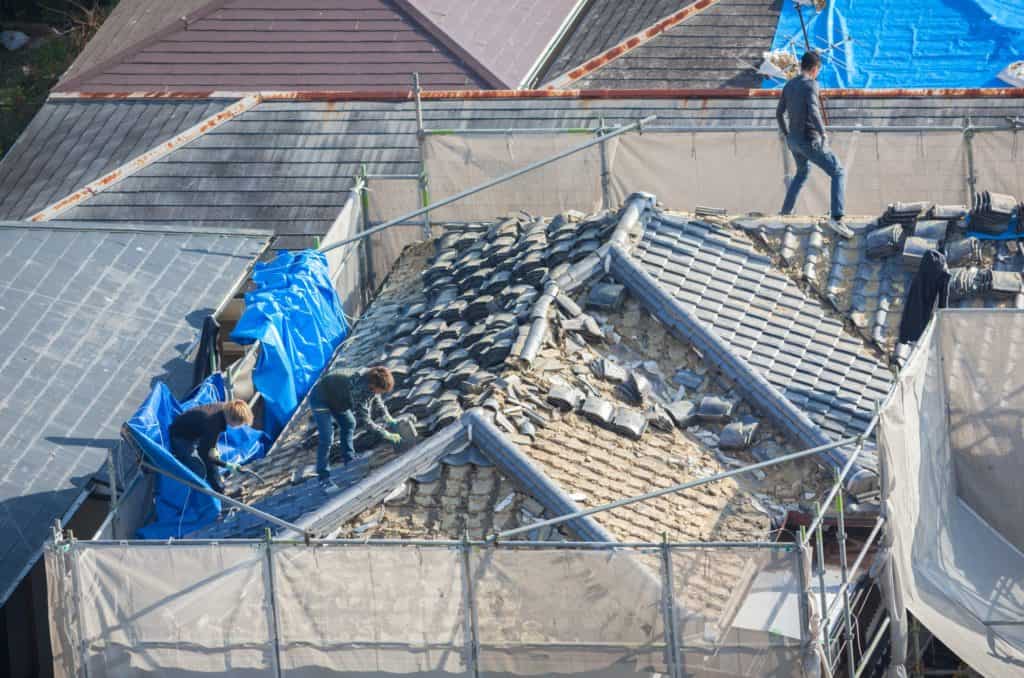When a storm damages your roof, there are several steps you should take. Call your insurance company and make a claim. In the meantime, repair the damage using roofing cement and other shingles. Alternatively, you can cover the roof with metal sheeting until you can replace the entire roof. If your roof is beyond repair, consider a replacement, but remember that this will take time and money.

Steps to take after a storm damages your roof
In the aftermath of a storm, there are several steps you should take to repair your damaged roof. First, contact your insurance provider, who may send out an adjuster to assess the damage. Make sure you take pictures of the damage, so you can document it. You may not even need to file a claim if the damage is minor.
If the water has reached your home, make temporary repairs while you wait for your insurance provider to send an adjuster. You can save all receipts so that you can claim any insurance reimbursement. If you need to hire a roofing contractor, it’s important to hire a certified contractor with experience with roof repairs. It’s best to avoid using a traveling contractor because of the risk of substandard work.
After a storm damages your roof, you must ensure the safety of your family and property. If necessary, evacuate your home. Make sure you don’t touch downed power lines. If possible, contact your utility company to find out how to restore power. When assessing the damage, be sure to document the damage with pictures and receipts.
Storm damage is expensive to repair. Wind damage, for example, can rip off roofing materials. When the winds are high enough, they can also cause tree branches to fall on the roof. This can damage gutters and other parts of the home. To avoid further damage, it’s crucial to document the extent of the storm’s damage.
Before you hire a roofing contractor, you should check your roof accessories for signs of damage. The ceilings, windows, and roof accessories should be checked for dents or soft spots. You should also check for signs of water damage or animal life in your attic.
While roof collapse is unlikely, your roof should be checked for signs of damage. If the damage is more serious, you may need to waterproof your roof. However, you can simply replace the shingles if the damage is minor.

Calling your insurance provider
Most home insurance policies cover storm damage expenses. However, your coverage may vary based on your policy type and location. If you notice damage to your roof following a storm, call your insurance provider to discuss your coverage. Your agent can help you understand your policy and help you plan for the unexpected.
First, you should determine how much damage was done by the storm. The damage may be in the form of gaps in shingles, bent or curled flashing strips, or missing roofing components. It may also affect the siding and windows of your home. If the storm damage is significant, you should contact your insurance provider and get a detailed repair cost estimate.
The insurance company will send a field adjuster to your property to inspect the damage. The adjuster may also require a roofing contractor’s inspection. Roofing contractors in the Middle Tennessee area can work with adjusters to assess the damages and scope of repairs. This will help you avoid missing any details when filing an insurance claim.
It would be best if you also took pictures of the damage. A hailstorm can cause significant damage to your roof. It’s important to report the damage to your insurance company immediately. It’s challenging to assess hail damage from the ground but look for cracks or peeling shingles. You may find animal life or shiny patches on the shingles, which can indicate roof damage.
Once you’ve obtained estimates from contractors in your area, contact your insurance company to schedule an appointment with a public adjuster. Ensure that your insurance adjuster is honest and fair while assessing the damage. Do not begin repairs until you receive the insurance company’s estimate.
In many states, hail and wind damage can cause unrepairable damage to your roof. Most homeowners insurance policies cover these types of damages, but there is a separate wind and hail deductible in some states. These deductibles can range from one to five percent of the value of your home.

Finding the source of the leak
Whether your roof is leaking due to storm damage or simply showing signs of damage, finding the source of the leak is an important first step in addressing the problem. You’ll want to check the roof inside and outside your home and look for cracks or easy-access points. Check the attic, chimney, and roof joints for signs of water intrusion. A bright light will help you see the spot and pinpoint the source of the leak.
You can begin by removing some insulation from your roof. Don’t forget to use protective gear. This will help you follow the water’s path to the entrance point. Also, examine the underside of the roof for any objects that might be protruding from the roof.
A leak on your roof can lead to electrical or fire damage. If you can safely access the attic, you can investigate the source of the leak by contacting a professional roofer. Getting a professional roofer is the best way to ensure your home’s safety.
Frequently, the source of a roof leak is located in the attic. If you notice a small area of wet ceiling boards, it’s time to search for the source of the leak. If you can’t locate the source, a small hole around the source can help drain the water and give you time to find the source.
During a storm, your roof takes a beating. Wind, water, hail, and debris can cause significant damage to your roof and your home’s interior. To prevent further damage, follow these tips for storm damage repair. You’ll soon be enjoying your home once again.
While a leak may appear small, it can cause significant damage to your roof and home. A leak can lead to mold growth and other structural issues if left untreated. Luckily, it’s easy to find the source of the leak in your roof if you know what to look for.
Once you’ve identified the source of the leak, you can begin the repair process. It may be necessary to call a professional roofer, but it is still possible to handle minor repairs yourself. However, if you’re uncomfortable with heights or climbing on roofs, you should seek the advice of a qualified professional.
Making a claim
If your roof has sustained storm damage, you should file a claim with your insurance company. The company may have a list of approved contractors. If your home is uninhabitable, the insurance company will reimburse you for your hotel costs. The insurance adjuster will also provide you with a proof of loss statement.
If the storm is severe, you may have to replace the entire roof. For example, if a tree has fallen on your roof, it could cause significant structural damage. However, inspecting your roof and mitigating any potential problems before making a claim is important. In addition, you need to check for signs of water or mold.
Regarding storm damage, homeowners insurance usually covers the cost of replacing the roof. Depending on your policy, you can also get reimbursement for temporary repairs or hotel stays while the roof is repaired. You should receive reimbursement within 30 to 60 days, but if you do not receive reimbursement within that time frame, you can appeal the denial of your claim.
Once you have discovered the damage to your roof, contact your insurance provider immediately. Most insurance providers have specific requirements regarding when and how to file a claim. It is important to act quickly after discovering storm damage. Otherwise, you risk denying your claim because it was not associated with the storm.
You should also be aware of the storm deductible, which is the amount of money you must pay out of your pocket before your insurer will reimburse you. This amount is usually around two to five percent of your insured value. If your roof is worth $100,000, you will need to pay out at least $10,000 of this amount. However, this does not mean you have to agree with the amount, and you can ask for more money if needed.
The insurance company may be reluctant to pay the full amount due to storm damage, so you may need to hire a public adjuster or seek a settlement with a lower offer. These professionals will help you get the right amount for your insurance claim. They can also help you to submit photos and estimates to support your claim.



